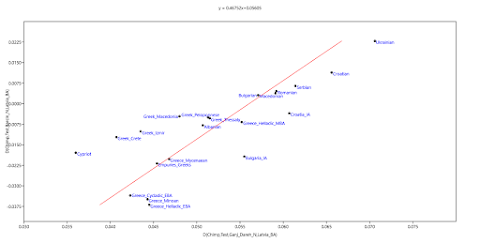search this blog
Friday, May 14, 2021
A Greek tragedy
I wasn't going to blog about the Clemente et al. "Aegean palatial civilizations" paper, because I think that it's a rather strange effort overall. But apparently a lot of people want to know my thoughts on the topic, so here goes.
If you download the relevant PDF file (here) and do a search for "Slav", you'll see that the word doesn't even appear in the bibliography. How is that possible, considering the massive impact that the Slavs had on the Balkans, including Greece, during the Middle Ages?
Indeed, here's a quote from page 12 of the PDF: "Present-day Greeks - who also carry Steppe-related ancestry - share ~90% of their ancestry with MBA northern Aegeans, suggesting continuity between the two time periods."
That's a very optimistic view. In fact, there's no evidence whatsoever in the paper that there's even 1% genetic continuity between present-day Greeks and any ancient Greek population, let alone the MBA northern Aegeans.
The genetic impact of Medieval Slavic migrations on most present-day Greek populations is easy to see. For instance, below are several linear models based on D-statistics of the form D(Outgroup,Test;Ancient1,Ancient2). You don't need a PhD in mathematics to understand them. The relevant data file is available here.
Note that most of the present-day Greek groups cluster together, and they also form fairly neat clines with the other Greeks, as well as Cypriots, other Balkan populations, including those speaking Slavic languages, and also the Slavic-speaking Ukrainians. On the other hand, they don't overlap with any of the ancient groups from Greece and surrounds, nor do they generally form obvious clines with them.
To me this suggests that most present-day Greeks harbor significant levels of Slavic ancestry and some sort of recent Cypriot-related ancestry, and in large part they're only coincidentally similar to ancient Aegeans, including those from the MBA (labeled Greece_Helladic_MBA in my graphs).
And let me assure you that no matter which ancient populations you run in such D-stats, you'll always see similar present-day Greek clusters and present-day Balkan clines.
Obviously, it's fair enough to assume that there's been some genetic continuity in the Aegean from the Iron Age, Bronze Age, and even the Copper Age and Neolithic era to the present-day. But the point I'm making is that no one has yet proved this, or even attempted to measure it properly.
See also...
Greek confirmation bias
Subscribe to:
Comments (Atom)


